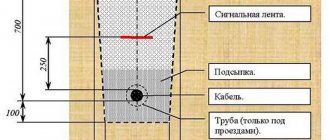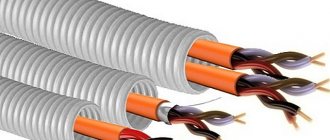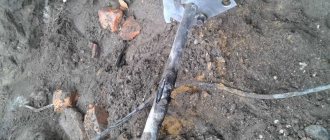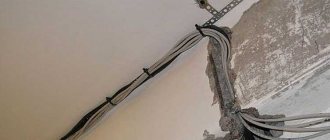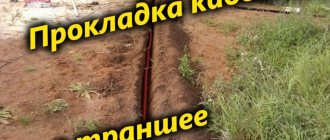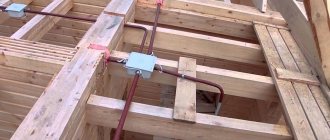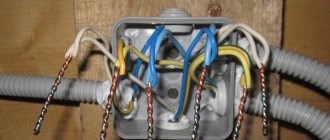Modern technologies make it possible to lay cables without the need to develop trenches and remove soil. Using the HDD method and special equipment, it is possible to create a well for a communication device with a diameter of up to 550 mm and a length of up to 50 m. It is used if it is necessary to lay a cable in a steel case under natural and artificial obstacles, regardless of their location.
To carry out drilling, there is no need to tear up pits or pits, since the soil is developed from the surface of the site. The process is carried out by a working tool, which initially drills the ground vertically, and when it reaches the planned mark, it is replaced with a horizontal position in accordance with a given trajectory. An HDD rig is installed at the construction site, equipped with rods and a drilling head, with the help of which a pilot hole is initially created. If it is necessary to increase its diameter, an expander is attached and pulled in reverse to its original position, breaking the soil and compacting it to the sides. The process is accompanied by the supply of a bentonite solution designed to fill empty spaces and eliminate the risk of soil collapse. A steel case is placed into the tunnel created and expanded to the required diameter, through which the working cable is passed.
You can lay communications underground using the trenchless method using another method - horizontally directed puncture. It is used for installing pipelines with a diameter of no more than 70 cm. To carry it out, it is necessary to prepare the starting and finishing pits, one on both sides of the object, under which a trenchless hole will be created. The equipment is placed in the starting one and the supporting wall is prepared.
Advantages of soil puncture compared to other methods:
- shorter order completion times;
- due to the main number of mechanized stages, less physical strength is required;
- lack of measures to restore the working area and the structures located on it for the reason that the puncture method is able to “bypass” all obstacles;
- access to work throughout the year.
The advantages also include the ability to lay pipelines made of any materials. The HDD method is becoming more popular every day, and in some countries the trenching of engineering systems is already completely prohibited.
The first stage of trenchless technology is to perform a pilot hole to create a horizontal well, which is later developed to the required diameter. At this point, the risks of geological destruction of the rock located above the pipe are eliminated. Afterwards the pipe is pressed down, while the pilot rod remains in the developed hole. Using a drilling rig, the soil is drilled out with the simultaneous removal of waste soil through a system of augers. As a result, the soil is removed from the product being laid and remains in a compacted state around it, allowing for the safe construction of underground communications.
If work is carried out in hard soils or pipes of large diameters are laid, then soil washing with a bentonite solution is used, which makes it easier to compact the earth around the work product.
Purpose of power drives
- Rotators are a unit and mechanism designed to rotate and feed a working tool.
- In the process of rotary drilling, mud pumps are used to regulate the optimal temperature of the tool that destroys rocks, as well as to clean the face of accumulated slurry.
- Lowering, extending and lifting columns for drilling is carried out using winches, towers, masts, traveling blocks, and pipe valves.
In addition to the drilling process, well construction consists of preparing the work site, transporting HDD equipment and related tools, installation and dismantling operations. Equipment for HDD can be stationary, mobile or self-propelled.
Stationary equipment is not equipped with its own base for transportation and is moved using other land or air transport. But it is designed in such a way that the process of delivery to the work site and back is carried out most conveniently, therefore it is made in the form of a collapsible structure that does not require special complex adjustments for full assembly, and also labor-intensive installation and dismantling is performed.
Mobile units have their own transport base. They are transported to the construction site using wheels, sleds or caterpillar tracks, and delivery by watercraft is also possible. The movement is carried out by the structure or several of its blocks. The greater their number, the number of installation and dismantling processes increases accordingly.
Self-propelled units are equipped with wheels or tracks, which completely reduces the time for transportation and preparatory work, which is especially valuable if short-term drilling is to be carried out.
Benefits of technology
List of advantages of using the described method of installing cable networks:
- Minimal changes in the landscape of the area;
- No impact on the quality of nearby roads;
- HDD does not imply a ban on traffic on adjacent roads;
- Short installation time for cable communications;
- The trenchless construction method does not leave behind mountains of selected soil;
- Cost-effective: HDD does not require additional workers, the process is mechanized. A controlled puncture does not require the use of additional special equipment.
The use of puncture technology under the road requires obtaining permits from the local administration. The drilling operator provides project documentation to the competent authorities. In addition to the drawings, an area survey report with signatures of the owner of the land plot, a responsible person from the local administration, and a representative of the contractor is provided.
If you are looking for high-quality consumables and spare parts for HDD installations, then you can definitely find them at TechService HDD, also at an attractive price.
Uses of bentonite
The pilot hole is expanded by a drilling rig using a puncture method, thereby laying pipes for transporting various substances. If drilling installations are used, then the process is accompanied by the introduction of a bentonite solution into the developed well through a flushing head. It is important that it does not exit through the inlet and outlet openings into the pits.
The use of a new portion of bentonite solution is permissible only after the previous one has been completely used up.
Cable laying by puncture
Please note that cable laying by puncture
eliminates the cost of labor-intensive excavation work that requires the use of special equipment. You save on resource labor costs, do not pay for the services of earth-moving machines, and save on planning, loading, and removal of soil.
In general, the puncture method is cheaper than standard cable laying measures, including:
- digging/filling trenches, pits;
- planning, soil removal.
| WE RECOMMEND! Savings amount to 40 - 50%! At the same time, the speed of work is reduced by three times. |
Microtunneling
The microtunneling machine is equipped with a drive located in the drilling head and cutting ring. To start the auger, a pressing station is used, fixed in the starting pit. A transport nozzle is placed in the working pipe, with the help of which drilling material is pumped into the starting pit, thereby preventing damage to the product being laid. The system is controlled by a target and a laser beam, so that for every 100 m of penetration, the deviation from the specified trajectory does not exceed 3 cm.
Using the HDD method
If you plan to use horizontal directional drilling, then remember that it will be carried out from the surface of the earth. Such a well will be formed by drilling a pilot channel. The main feature of this method is that it is possible to control the direction of drilling. Thanks to this, you can independently determine the cable path.
Trenchless installation of HDD cable also involves the formation of a pilot channel. It is performed by drilling a steel shaft into the ground, which has a drill head.
According to HDD technology, a special solution will also be injected into the channel. This solution prevents the rock from collapsing in the future. This procedure will take place under high pressure. When the pilot hole is completed, then specialists will attach a special reamer to the drilling head. In the future, a special polyethylene pipe, also called a case, will be attached to the expander. Specialists will install a steel cable in a special case, which will help pull the cable through. If you are interested, then you can read what types of electrical wiring there are.
Development of a pilot well
A controlled head, on which there are special holes for supplying mortar, is pressed into the ground. Thanks to the probe built into the head, a signal about its movement is transmitted, and the operator can control it by changing its trajectory. After its exit in the receiving pit, it is replaced by an expander and a swivel, in which there are holes for supplying bentonite solution. When sinking is carried out in several stages, the pipe being laid is attached to the swivel, after which the prefabricated structure is tightened in the opposite direction. At this moment, a large volume of bentonite solution is supplied, pushing the soil along the workpiece. With this method it is impossible to carry out penetration exactly with a given trajectory, so it is not used when laying gravity pipelines, however, it can be used to successfully lay communication lines and pressure pipelines.
Using a Cable Layer
The technology for carrying out such work is quite simple. Before laying, it is mandatory to mark the place where the cable will be laid in the future. Now, using a special knife, the cable layer will gradually begin to cut the soil until a gap forms in the ground into which the cable will be installed.
The depth to which the cable is laid must be controlled. It will be monitored every 40 meters. When, as a result of laying, the cable on the drum begins to run out, then its end will be fastened to another drum and work will continue. At the fastening site, specialists will install a special coupling. In most cases, trenchless wiring will begin with a calculation.
Specialists must calculate and make sure that further cable fastening points are accessible for further inspection. The connection should never be made in wetlands or ravines. When using this technology, the cable line will be laid by special cable layers. They are capable of stretching armored cables with voltages up to 10 kilowatts. If this type of installation is compared with laying cables in trenches, then we can say that this method is less labor-intensive.
We already have an article on how to lay wiring in the ground, and you can study it and learn the differences between laying methods. In the video below, you can see all the stages of such work.
It is important to know! Trenchless cable laying can also be carried out in water, under ravines, forests or roads. In this case, laying will be carried out in the following ways: horizontal drilling of the soil or by puncture. A similar technique should also be used in places where gas or oil pipelines are present.
HDD
Using a trenchless transition device, pipes made of various materials are laid. The advantages of the HDD method are the preservation of the landscape, while spot digging of pits or installation of a small utility room is carried out. There is also no need to block transport routes, dismantle structures located on the work site, or destroy green spaces.
Initially, a geological study of the soil and the territory as a whole is carried out for the presence of located underground and above-ground obstacles, after which the selection of equipment with which the drilling will be carried out is made.
The next step is to carry out pilot drilling, as a result of which the working rod forms a hole in the ground.
The third stage is the expansion of the developed hole to the required diameter in accordance with the pipe being laid, or the process of pressing the working pipe in the direction of the pilot well.
The drilling method is one of the most advanced construction technologies, with the help of which new pipelines are laid or old pipelines are repaired/replaced. For this purpose, a pilot well is developed, after which it is expanded to a given diameter and filled with bentonite solution. The pipe is pulled from the opposite end using the method of fastening to a rod and reverse penetration, or it is pressed into place from the starting pit.
Trenchless technology is in demand due to a large number of positive features: electrical installation work is carried out without destroying the landscape and road surface, pipes are stretched under any buildings, rails, parks, lakes, etc.
Trenchless cable laying
Trenchless cable laying
beneficial due to the following advantages:
- eliminating the need for subsequent restoration of the fertile soil layer, preserving the landscape;
- no need to restore asphalt surfaces of roads, highways, pedestrian sidewalks, paved areas;
- preservation of existing communications without the need to restore them after the puncture;
- eliminating the need for approval and permission to block highways and transport links.
Bentonite
To increase productivity and maximize the efficiency of the horizontal drilling process, a bentonite solution is used as a support and lubricant. If work is carried out on coarse-grained or washed-out soils, then bentonite is used to fix the pipe in the desired position. During the process of pressing or drilling a hole, bentonite solution is used as a lubricant, simplifying the passage of the working tool or pushing the pipeline segment being laid.
The flow rate depends on the proportion of bentonite. This makes it possible to produce a suspension intended to support the product being laid or a solution that acts as a lubricant.
If the pipe is immersed entirely in bentonite, then it begins to act with a buoyant force due to the air contained in the work product. This ensures a reduction in friction between the pipe walls and the soil during the pressing process.
The pipeline can be laid using the HDD method into existing lines or a new hole can be developed. The first method is carried out using a hydraulic calibrator, designed to free up space, as a result of which it is possible to install a new pipe.
The hole is developed if there are no lines prepared earlier or if they are in an emergency condition, in which it is impractical to carry out repair work.
The pipeline is laid using the HDD method, designed to create routes no more than 10 meters long. An obstacle may be groundwater that erodes the soil. However, in this case, there is a solution: lay the pipes by placing them in cases.
The pilot rod creates a hole and exits through the receiving pit. Sections of the pipeline being laid, the diameter of which is no more than 300 mm, are welded to it. A rotating auger is installed inside the pipe, with the help of which the waste soil is removed and brought into the starting pit, from where it is removed by grab equipment. A welding machine is used to connect pipeline sections.
Puncture device
A pipe made of steel, with its open edge, is pressed into the soil using a trenchless method, thanks to which new communications are built or old pipelines are repaired. A special installation is used to press the pipe. At the open end, the earth is filled with a “pillar”, and then it is removed from the face.
The compact design of the drilling rig includes a frame equipped with hydraulic cylinders in a number depending on the type of soil and difficulties that may arise in the process. The drive is one of the engines, which is started in the presence of electricity, diesel or gasoline. Suitable for the construction of utility networks for any purpose under railway crossings, highways and densely built-up areas. The uniqueness lies in the fact that there is no need to dig trenches, as a result of which the execution time is reduced and the integrity of the buildings located on the work site is preserved.
CALCULATION OF THE COST OF HDD
We suggest using the free HDD Calculator by specifying just a few parameters: pipe diameter, length, pipe material and quantity, you will receive a preliminary calculation of the puncture
If you are experiencing difficulties with the calculation, or you need to enter additional parameters that affect the final cost of the calculation, for example, the presence of communications in the well drilling area, the presence of free space at the equipment installation site and the puncture site, the specifics of the puncture site (business, time of work), the specifics of the soil etc. Book a consultation by clicking the button below.
How to dispose of waste soil
For soil disposal, a special classification has been developed, according to which it is divided into five categories. High-risk soil is intended exclusively for removal to landfills specializing in the disposal of toxic waste.
If a construction company intends to use waste land in the future, it is necessary to conduct laboratory tests, and if hazardous substances are not identified, it will be available for use.
When constructing a building, the site is initially marked out, after which ground work begins. Before you begin, you should decide on the depth of the pits being developed, because this determines how much earth needs to be removed. If a building is being erected without a basement, then it is quite possible to carry out excavation work manually, which will save the budget. If it is necessary to construct a basement floor, the process is only possible with special equipment. However, regardless of the method of work, in any case it is necessary to strengthen the walls of the pits.
To more effectively extract earth from pits, the top layer, about 50 cm high, is placed separately from the subsequent ones, as it is suitable for gardening and landscape work.
Strengthening pits is the main task in the process of developing and removing soil from them. It is made using shields made of boards, which are fixed on a common plank and installed at the bottom of the pit. You can also strengthen the walls and base of the pit using bentonite solution, but the method is carried out with special equipment.
In the process of installing new communications for various purposes and connecting them to a common engineering network, sometimes an obstacle arises such as transport routes.
In this case, it is advisable to carry out a trenchless transition using HDD technology or to carry out a puncture under the railway tracks, which makes it possible to lay the pipeline under the transport routes, without the need to open the roadway or block the movement of vehicles.
Stages of work
- Development and approval of the project. At the preliminary stage, a detailed study of the area is carried out - soil features, layout diagrams of existing utilities.
- Delivery of equipment to the work site, its installation and connection.
- Drilling a pilot well and treating the walls with drilling fluid.
- Expansion of the channel to the dimensions established by the project. The soil selected during the work is removed from the well, then the well is strengthened with bentonite.
- Placing pipes in the well.
At the final stage, the puncture is accepted by the electrical contractor; a technical supervision specialist, a cable network worker, also participates in the approval process. After approval has been completed, the laying of cable lines and their pulling through the puncture begins. Then the documents are re-accepted and endorsed. Such multi-stage coordination is necessary to comply with safety standards established by law.
+7
Free estimate
Call us or fill out the form.
We will contact you shortly and advise you on all questions. Leave a request
Where is the puncture method used?
In any situations where damage may be caused to the environment, buildings and structures at the work site, vehicle traffic, etc., as well as in cases where the use of the open method is prohibited or simply impossible to implement, then it is advisable to lay pipelines using the trenchless puncture method. However, it can be used if the pipeline string or one pipe intended for installation has a diameter of no more than eight meters.
HDD is a dangerous method, therefore a number of requirements are established for the accuracy of calculations and drilling, safety precautions, studying the characteristics of soils and preventing their settlement. Work can begin only after there is a permit from the Russian Railways administration, which is responsible for a specific section of the tracks.
Design of cable piercings
Mechanized laying of a cable line under the ground, without resorting to digging a standard trench, brings greater efficiency and benefits, since:
- all kinds of communications are successfully laid to a depth of no more than 20 meters;
- the pipeline used for puncture has a diameter of up to 1200 mm;
- puncture without exits to the surface with a maximum length of 1000m.
There is a special approved project for the manufacture of pipes during the HDD procedure. According to these rules, the pipe can be steel, reinforced concrete, PVC and PE.
What are the advantages of the puncture method?
During a trenchless transition, special steel cases are used, which are pushed by a pump-jacking unit into the developed well with translational movements, due to which the soil does not crumble.
Advantages compared to other methods:
- Lower price.
- Reduced work time.
- No additional arrangement of the work area is required.
- Groundwater does not affect the process, so there is no need to dewater when installing a utility network using the puncture method.
- Upon completion of the work, there is no need to restore the surface or recreate the paths.
Work on and under railway tracks is complex and dangerous and is therefore carried out exclusively by qualified specialists. To use the HDD installation, it is necessary to prepare the site for its placement.
If it is necessary to carry out work in rocky or hard soils and to place large-diameter communications, then the trenchless drilling method is used.
Safety regulations during HDD drilling are developed to ensure the protection of the health and lives of members of the working team, and to reduce the risk of breakdown of the equipment used.
Persons at least 18 years of age are allowed to work with drilling rigs. Before starting construction work, they must undergo a medical examination, followed by instruction, and then confirm their knowledge and skills in an exam.
Before using any equipment, each worker must thoroughly study the instructions provided by the supplier and ultimately comply with the operating conditions. The installations and work site are kept in a condition that satisfies the instructions. No strangers are allowed on the work site.
During breaks between work processes, builders are prohibited from settling on the ground or in grass, bushes - areas located near the operation of drilling rigs. The staff must have a specially designated and equipped room that meets hygienic standards, in which they can dry their clothes, take a lunch break, and rest if necessary. It is imperative to have a first aid kit containing all the necessary medications to be able to immediately provide first aid.
What is trenchless pipe laying and how does it work?
The essence of the method is to draw a highway under the surface of the earth, as opposed to digging surface trenches, which have the following disadvantages:
- Removing soil leads to the destruction of the upper fertile layer not only in the trench, but also by special equipment, as well as to contamination of the surrounding area, which significantly increases the scale of damage.
- With the trench method, plantings (trees, shrubs) are damaged, which cannot always be restored.
- When carrying out work on asphalt roads and pedestrian roads, the asphalt coating is destroyed, the use of the routes becomes impossible and further repairs are required - this brings inconvenience and is not economically profitable.
The advantages of the trench method include the simplicity of the technology, available in households, and the prevalence of the equipment used; also, digging trenches does not require highly qualified workers.
When using the trenchless method, installation and laying of the pipeline is carried out using drilling equipment, pass-through units, hydraulic and pneumatic punches.
Completion of work
After the drilling work is completed:
- The drilling rig and all its elements are inspected, contamination is removed, and the cable and hose are disconnected.
- If bentonite solution remains, it must be drained and then the tanks must be washed. Remove from the pit before backfilling with soil. The remaining solution is transported to special sites where it is disposed of.
- Work areas are leveled and measures are taken to restore landscaping. Fencing partitions and special signs are dismantled, and garbage is removed.
HDD technology is the construction of pipelines underground without surface development, which prevents disruption of the site’s landscape, the integrity of the asphalt pavement, the destruction of green spaces, etc. The method is implemented in various ways depending on the type of utility network, its technical characteristics and geological conditions of the area.
Restoration of old networks is called sanitation, and is carried out to repair or replace a fragment of a pipe laid previously. Can be done in one of the following ways.
In the first of them, the old fragment is preserved and serves as a protective case for the new pipe. It is first cleaned of debris, after which a communication of smaller diameter is placed in it. The area being repaired is disconnected from the general system.
Relining involves repairing old communications by laying new pipes through them. Renovation consists of replacing the pipeline with a new one, while the old communication is destroyed and it is possible to lay a new product of any diameter in accordance with the size of the hole.
The puncture method is intended for excavation work mainly in clay and loamy soils. The development of a well using a HDD installation is necessary for the installation of utility networks, the diameter of which does not exceed 600 mm, the length of penetration is no more than 60 m. The introduction of a working tool is accompanied by compaction of the soil. A hydraulic jack is used to carry out a puncture.
Reducing friction and soil resistance on the pipe being laid is achieved by using a cone-shaped tip protruding several centimeters in relation to the pipe itself. If the work piece has a small diameter, then it is not necessary to use such a tip - the puncture method is carried out using a laid communication.
The method of creating a well by punching is mainly used for installing communications made of steel, the diameter of which does not exceed 2000 mm. Punching is similar to the puncture method, however, the difference is that it is carried out with the open end of the pipe, after which the accumulated soil is removed from it. Sufficient force is created by hydraulic jacks, which are installed symmetrically along the entire diameter of the product being laid. It is used for the installation of pipelines with a diameter of 600 to 1700 mm, with a length of no more than 100 m.
First of all, the pits are prepared. At the starting point, a support wall is installed to which the jacking equipment is attached. One edge of the pipe being laid is connected to jacks. The second end begins the pressing process.
The construction of underground communications is carried out by horizontal drilling using a drilling rig. A pilot well is being developed. The sharp tip is replaced by an expander, with the help of which the hole expands to the required diameter. The working tool has small holes through which bentonite solution is supplied. It is used to cool the expander, improve its penetration and compact the soil. Also, the pipe being laid can be placed in a bentonite suspension, due to which it will be fixed in one position. The pipeline string is attached to the rod and pulled in reverse through the developed well.
Bentonite is used to facilitate the process of horizontal drilling in hard soils, as well as as a support or lubricant. When laying in coarse-grained or washed-out soil, bentonite mixtures are able to support and fix the pipe. Bentonite is used during pipeline pressing and during trenchless drilling as a lubricant to ensure better drill head permeability, as well as to push the pipe.
It is important to understand for what purpose bentonite is used; because of this, the yield strength will differ, depending on its concentration in the mixture. Since it can be used as a support or as a lubricant, it is necessary to know what proportions are correct. The proportions of bentonite differ depending on the average grain size in the soil.
Immersion of the pipeline in bentonite solution
When drilling a pipe filled with air and immersed in a bentonite solution, a buoyant reaction can often be observed, the strength of which depends on the material of the pipeline. Thanks to this phenomenon, the friction of the outer walls of the pipe during the pressing process is reduced. It is important to correctly determine the required concentration of bentonite and pump it evenly, since the result of horizontal trenchless drilling may depend on this. The quality of the bentonite suspension also affects the depth and number of deformations of the pipe, which will subsequently affect its service life.
Unused bentonite solution is strictly prohibited from being left on the construction site. It is necessary to suck it out using suction pumps (sewage disposal units), followed by draining it to places designated for the disposal of liquid materials.
Bentonite slurry can also be disposed of using an innovative method based on an absorbent polymer, which reduces the volume by up to half. The application is aimed at the transition of the liquid state of bentonite into a solid state, after which it is suitable for backfilling pits, or loading with an excavator and transporting from the work site. The technology is safe for the environment.
The recycling process is carried out using a special installation, the small dimensions of which allow it to be easily transported to the work site.
Depending on the design, a submersible pump can be one of the types - a rod or rodless unit. The first type is equipped with a system of rods that rotate from equipment installed underground or on the surface. The design of the rotating mechanism is a housing with an installed hydraulic pumping product, thanks to which the work is carried out efficiently and as productively as possible.
In rodless submersible pumps, the rotating mechanism is located next to the hydraulic pumping part in the same housing. The design gets the job done efficiently and is the most productive among submersible pumps. The rodless design is often used for fecal and drainage pumping.
Submersible pumps are used in various fields and are indispensable for carrying out certain activities, for example, with their help it is easy to pump fecal liquids, liquefied gases, dispose of sludge, and pumping equipment is also used for installing water supply systems in private homes, water disposal in drainage systems, controlled irrigation, reduction waters on oil lakes.
When submersible pumps and rainwater installations work together, an ideal complex is obtained for use in agricultural land.
Small pumping systems based on submersible mud pumps are used to pump out flooded basements, eliminate water due to rising rivers and spring floods, and also use them to eliminate spills on personal plots.
Characteristics
Submersible industrial and slurry pumps are capable of pumping liquids consisting of up to 61% solid inclusions, with a fraction of at least 1 cm. The units have different capacities, can be very compact for private work, as well as industrial ones, capable of performing a large amount of work. Some of them are placed on travel trailers. The drives of the units are powered by electric current and diesel stations provided along with the submersible pump.
Submersible mud pumps are used to pump large volumes of liquids containing solids. The systems are also used for pumping liquid feces.
Efficient use and maximum performance of the bypass pump throughout the entire operating period can be ensured by regular, timely technical inspection and appropriate maintenance.
Any pumping installation must be inspected and serviced after every 250 operating hours. The minimum that needs to be done is to change the oil and filter, and if you ignore this, a breakdown may occur right on the construction site. As soon as one operating cycle is completed, the mechanical seal, connecting elements and their reliability, with which the motor, pump and reed valve are connected, are checked. The level and quality of the oil in the mechanical seal is checked, and its surfaces are lubricated with copper grease, thereby preventing premature wear.
On mobile pumps, the motor and fastening elements are first checked. If they are misaligned relative to each other, the bearings may wear out before the time specified by the manufacturer.
Then the bearings are inspected and the degree of their heating is checked - under normal conditions overheating should not occur. Proper performance depends on checking clearances in the design: impeller, wear ring, wear plate. They must not deviate from the norm, otherwise the circulation of water will be disrupted and the pump will not cope with the given volumes and pressure of the liquid, as a result, water will not be able to pass through the hole and ensure the functioning of the impeller.
Every 250 working hours a vacuum test is carried out, during which it is subjected to vacuum pressure at a pressure of 24 d.r. With. If the pump fails the test, it means that it has insufficient suction power, therefore, it is necessary to carry out a full inspection and repair damage. Otherwise, you will have to work with less water, increasing fuel consumption and time.
Also, to determine the efficiency of the bypass pump, dynamic testing is carried out, which consists of testing the equipment for three hours in a mode corresponding to the design conditions. A positive result is functioning in accordance with the design curve. And also, with the help of testing, it becomes possible to assess the condition of the fuel and eliminate leaks and radiator leaks. To determine whether the equipment can operate with the same performance in winter and summer, it is started and operated for two hours under the influence of extreme temperatures.
There should be no foreign objects in the supply system or inside the equipment, such as paper, rags, small parts, etc. If blockages occur, a vacuum will not be created, and this can be determined using sensors that indicate a problem. It is also necessary to monitor the float indicators and prevent them from entering the pump, which happens due to the accumulation of construction debris on the product.
As progressive cities develop more and more every day, there is a need to construct new buildings that will serve as office space or residential complexes. But due to such rapid growth, it is becoming increasingly difficult to lay new or replace old communications. Digging trenches does not give the desired results, since after using this method, highways, walkways and landscape at the construction site are damaged. In order to avoid such consequences, utility networks should be laid using trenchless technology and special equipment.
